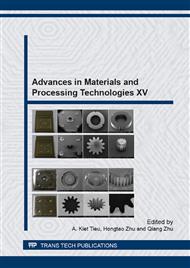p.28
p.39
p.47
p.56
p.63
p.70
p.79
p.89
p.95
Finite Element Analysis and Mold Design of Forging Process of Highway Bicycle Pedal
Abstract:
Forging is a simple and low-cost mass production process. Metallic materials can be processed using plastic deformation. This research analyzes an innovative forging mold design for the highway bicycle pedal. A series of simulation analyses in which the variables depend on various temperatures of forging billet and mold, friction factors, and forging speed show effective stress, effective strain, and die radial load distribution for a forging process and mold design of a highway bicycle pedal. Finally, we identify the results of simulation analyses with the design of an experimental forging mold to lower deformation behavior of a highway bicycle pedal. The analysis results provide highway bicycle pedal forming mold references to identify whether it is suitable with the finite element results for high-strength mold design.
Info:
Periodical:
Pages:
63-69
Citation:
Online since:
November 2013
Keywords:
Price:
Сopyright:
© 2014 Trans Tech Publications Ltd. All Rights Reserved
Share:
Citation:


